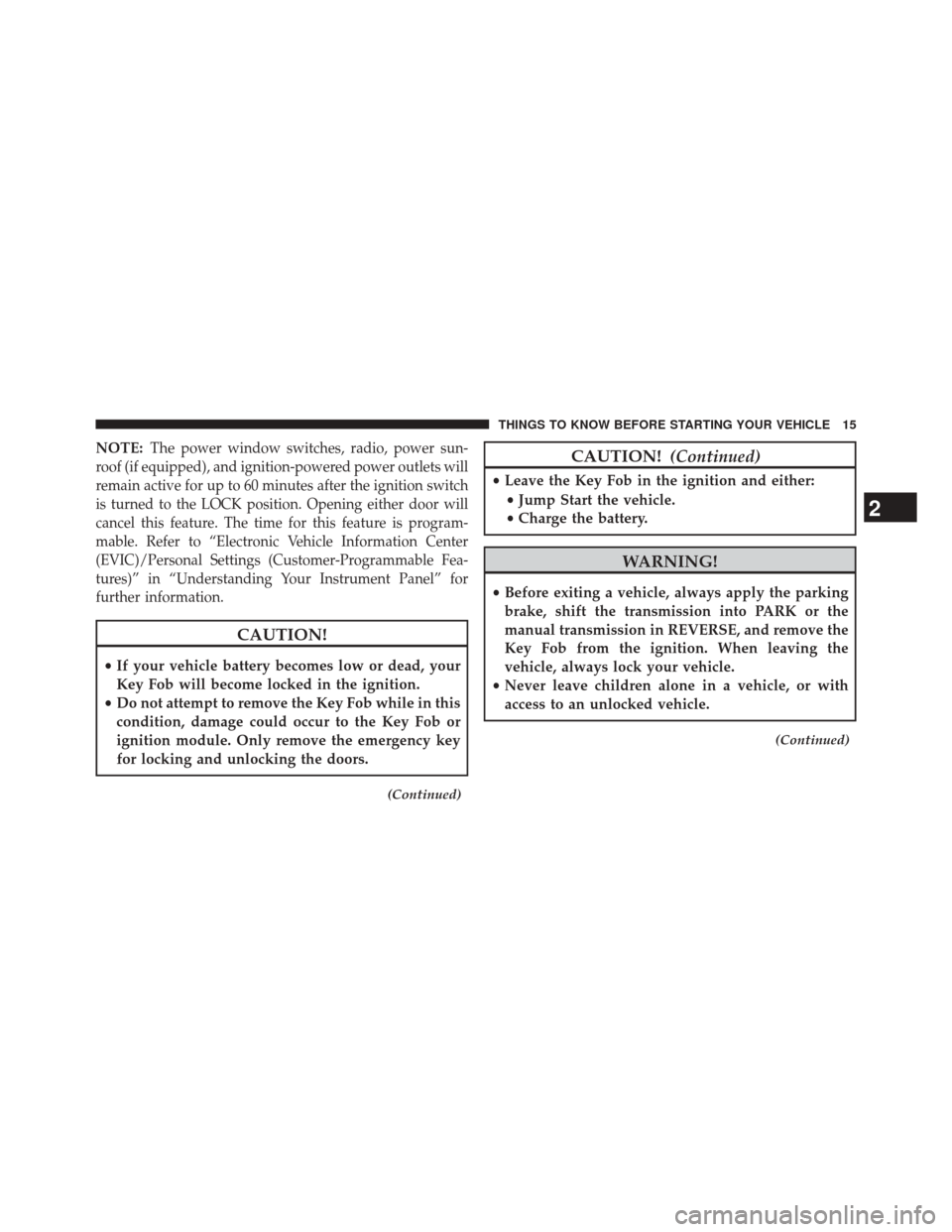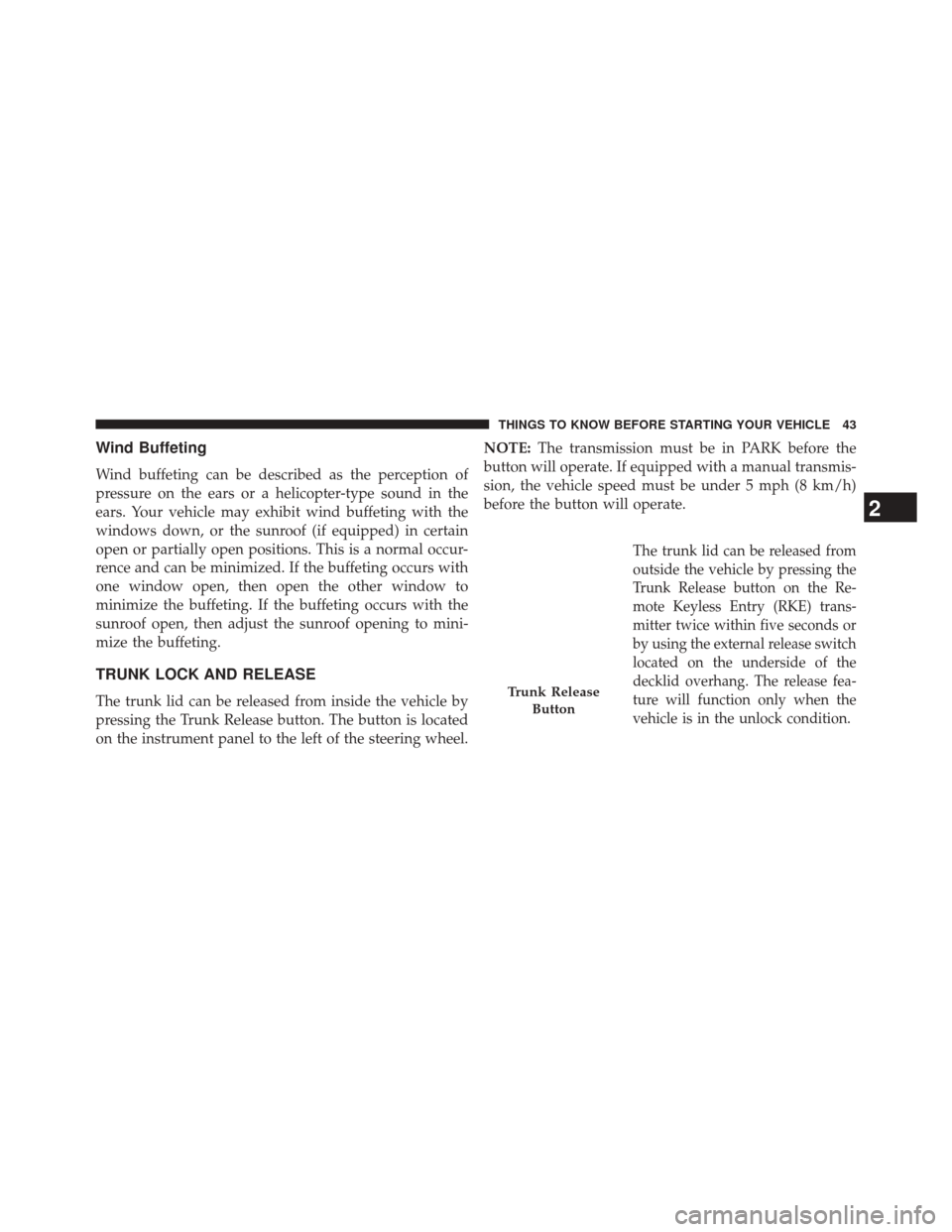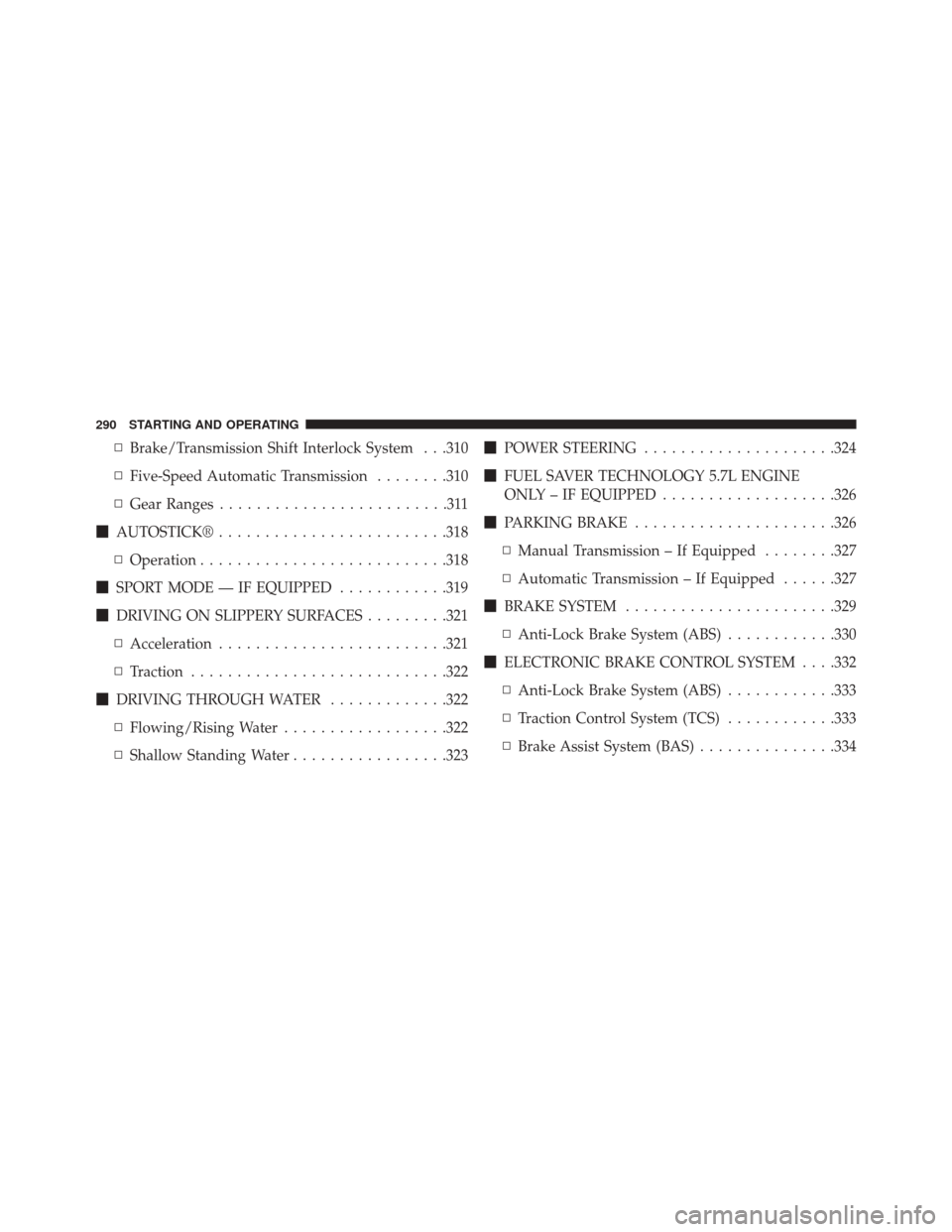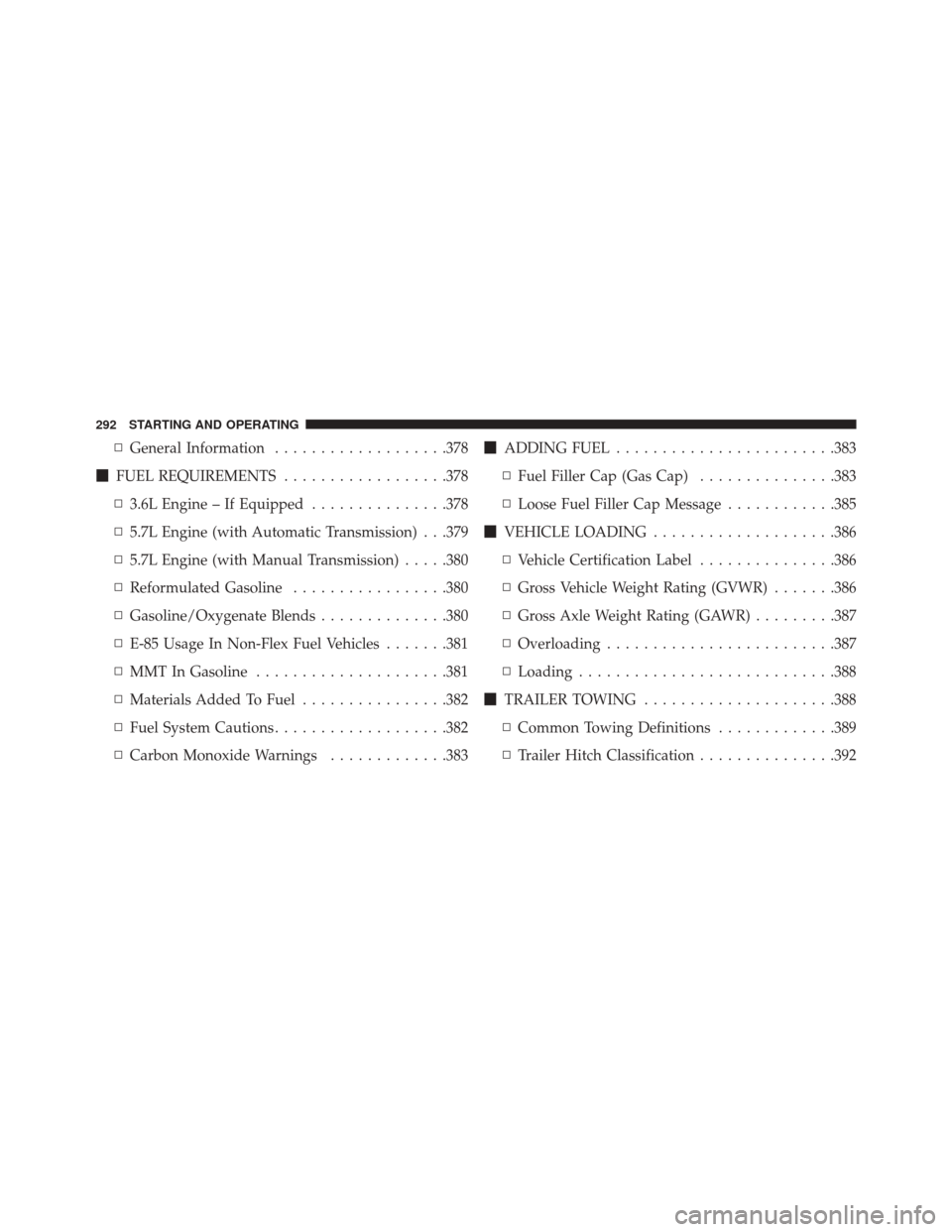Page 16 of 543
To remove the emergency key, slide the mechanical latch
at the top of the Key Fob sideways with your thumb and
then pull the key out with your other hand.
NOTE:You can insert the double-sided emergency key
into the lock cylinders with either side up.Removing Key Fob From Ignition
Place the shift lever in PARK or place the manual
transmission in REVERSE and apply the parking brake.
Turn the Key Fob to the OFF position and then remove
the Key Fob.
With the Keyless Enter-N-Go™ system, the EVIC will
display the ignition switch position “OFF/ACC/RUN”.
Refer to “Electronic Vehicle Information Center (EVIC) —
If Equipped” in “Understanding Your Instrument Panel”
for further information.
Emergency Key Removal
14 THINGS TO KNOW BEFORE STARTING YOUR VEHICLE
Page 17 of 543

NOTE:Thepower window switches, radio, power sun-
roof (if equipped), and ignition-powered power outlets will
remain active for up to 60 minutes after the ignition switch
is turned to the LOCK position. Opening either door will
cancel this feature. The time for this feature is program-
mable. Refer to “Electronic Vehicle Information Center
(EVIC)/Personal Settings (Customer-Programmable Fea-
tures)” in “Understanding Your Instrument Panel” for
further information.
CAUTION!
• If your vehicle battery becomes low or dead, your
Key Fob will become locked in the ignition.
• Do not attempt to remove the Key Fob while in this
condition, damage could occur to the Key Fob or
ignition module. Only remove the emergency key
for locking and unlocking the doors.
(Continued)
CAUTION! (Continued)
•Leave the Key Fob in the ignition and either:
• Jump Start the vehicle.
• Charge the battery.
WARNING!
•Before exiting a vehicle, always apply the parking
brake, shift the transmission into PARK or the
manual transmission in REVERSE, and remove the
Key Fob from the ignition. When leaving the
vehicle, always lock your vehicle.
• Never leave children alone in a vehicle, or with
access to an unlocked vehicle.
(Continued)
2
THINGS TO KNOW BEFORE STARTING YOUR VEHICLE 15
Page 45 of 543

Wind Buffeting
Wind buffeting can be described as the perception of
pressure on the ears or a helicopter-type sound in the
ears. Your vehicle may exhibit wind buffeting with the
windows down, or the sunroof (if equipped) in certain
open or partially open positions. This is a normal occur-
rence and can be minimized. If the buffeting occurs with
one window open, then open the other window to
minimize the buffeting. If the buffeting occurs with the
sunroof open, then adjust the sunroof opening to mini-
mize the buffeting.
TRUNK LOCK AND RELEASE
The trunk lid can be released from inside the vehicle by
pressing the Trunk Release button. The button is located
on the instrument panel to the left of the steering wheel.NOTE:
The transmission must be in PARK before the
button will operate. If equipped with a manual transmis-
sion, the vehicle speed must be under 5 mph (8 km/h)
before the button will operate.
The
trunk lid can be released from
outside the vehicle by pressing the
Trunk Release button on the Re-
mote Keyless Entry (RKE) trans-
mitter twice within five seconds or
by using the external release switch
located on the underside of the
decklid overhang. The release fea-
ture will function only when the
vehicle is in the unlock condition.
Trunk Release
Button
2
THINGS TO KNOW BEFORE STARTING YOUR VEHICLE 43
Page 215 of 543

6. Charging System Warning LightThis light shows the status of the electrical charg-
ing system. The light should turn on when the
ignition switch is placed in the ON/RUN position and
remain on briefly as a bulb check. If the light stays on or
turns on while driving, turn off some of the vehicle’s
non-essential electrical devices (i.e., radio) or slightly
increase engine speed (if at idle). If the light remains on,
it means that the charging system is experiencing a
problem. See your local authorized dealer to obtain
service immediately.
If jump starting is required, refer to “Jump Starting
Procedures” in “What To Do In Emergencies”. 7. Electronic Throttle Control (ETC) Warning Light
This light will turn on briefly as a bulb check
when the ignition switch is placed in the ON/
RUN position. This light will also turn on while
the engine is running if there is a problem with the
Electronic Throttle Control (ETC) system.
If the light comes on while the engine is running, safely
bring the vehicle to a complete stop as soon as possible,
place the shift lever in PARK, for manual transmission
place the transmission in neutral, apply the parking
brake, and cycle the ignition key. The light should turn
off. If the light remains lit with the engine running, your
vehicle will usually be drivable. However, see an autho-
rized dealer for service as soon as possible.
If the light is flashing when the engine is running,
immediate service is required. In this case, you may
experience reduced performance, an elevated/rough idle
or engine stall, and your vehicle may require towing.
4
UNDERSTANDING YOUR INSTRUMENT PANEL 213
Page 291 of 543
STARTING AND OPERATING
CONTENTS
�STARTING PROCEDURES ................294
▫ Manual Transmission – If Equipped ........294
▫ Automatic Transmission – If Equipped ......295
▫ Keyless Enter-N-Go™ – If Equipped ........296
▫ Normal Starting ...................... .297
▫ Extreme Cold Weather (Below –20°F
Or �29°C) ......................... .300
▫ If Engine Fails To Start .................301
▫ After Starting ....................... .303
� ENGINE BLOCK HEATER – IF EQUIPPED . . . .303 �
MANUAL TRANSMISSION —
IF EQUIPPED ........................ .304
▫ Six-Speed Manual Transmission ...........304
▫ Shifting ............................ .305
▫ Recommended Shift Speeds ..............306
▫ 1–4 Skip Shift ....................... .307
▫ Downshifting ....................... .308
� AUTOMATIC TRANSMISSION —
IF EQUIPPED ........................ .308
▫ Key Ignition Park Interlock ...............310
5
Page 292 of 543

▫Brake/Transmission Shift Interlock System . . .310
▫ Five-Speed Automatic Transmission ........310
▫ Gear Ranges .........................311
� AUTOSTICK® ........................ .318
▫ Operation .......................... .318
� SPORT MODE — IF EQUIPPED ............319
� DRIVING ON SLIPPERY SURFACES .........321
▫ Acceleration ........................ .321
▫ Traction ........................... .322
� DRIVING THROUGH WATER .............322
▫ Flowing/Rising Water ..................322
▫ Shallow Standing Water .................323 �
POWER STEERING .....................324
� FUEL SAVER TECHNOLOGY 5.7L ENGINE
ONLY – IF EQUIPPED ...................326
� PARKING BRAKE ..................... .326
▫ Manual Transmission – If Equipped ........327
▫ Automatic Transmission – If Equipped ......327
� BRAKE SYSTEM ...................... .329
▫ Anti-Lock Brake System (ABS) ............330
� ELECTRONIC BRAKE CONTROL SYSTEM . . . .332
▫ Anti-Lock Brake System (ABS) ............333
▫ Traction Control System (TCS) ............333
▫ Brake Assist System (BAS) ...............334
290 STARTING AND OPERATING
Page 293 of 543

▫Hill Start Assist (HSA) – Manual
Transmission Only ....................335
▫ Electronic Stability Control (ESC) ..........337
▫ ESC Activation/Malfunction Indicator Light
And ESC OFF Indicator Light ............341
� TIRE SAFETY INFORMATION .............342
▫ Tire Markings ....................... .342
▫ Tire Identification Number (TIN) ...........346
▫ Tire Terminology And Definitions ..........348
▫ Tire Loading And Tire Pressure ...........349
� TIRES — GENERAL INFORMATION ........354
▫ Tire Pressure ....................... .354
▫ Tire Inflation Pressures .................356
▫ Tire Pressures For High Speed Operation . . . .357 ▫
Radial Ply Tires ..................... .358
▫ Tire Types .......................... .358
▫ Run Flat Tires – If Equipped ..............360
▫ Spare Tires – If Equipped ................360
▫ Tire Spinning ....................... .363
▫ Tread Wear Indicators ..................363
▫ Life Of Tire ........................ .364
▫ Replacement Tires .....................364
� TIRE CHAINS (TRACTION DEVICES) .......366
� TIRE ROTATION RECOMMENDATIONS .....367
� TIRE
PRESSURE MONITOR SYSTEM (TPMS) . . .368
▫Base System ........................ .371
▫ Premium System – If Equipped ............373
5
STARTING AND OPERATING 291
Page 294 of 543

▫General Information ...................378
� FUEL REQUIREMENTS ..................378
▫ 3.6L Engine – If Equipped ...............378
▫ 5.7L Engine (with Automatic Transmission) . . .379
▫ 5.7L Engine (with Manual Transmission) .....380
▫ Reformulated Gasoline .................380
▫ Gasoline/Oxygenate Blends ..............380
▫ E-85 Usage In Non-Flex Fuel Vehicles .......381
▫ MMT In Gasoline .....................381
▫ Materials Added To Fuel ................382
▫ Fuel System Cautions ...................382
▫ Carbon Monoxide Warnings .............383�
ADDING FUEL ....................... .383
▫ Fuel Filler Cap (Gas Cap) ...............383
▫ Loose Fuel Filler Cap Message ............385
� VEHICLE LOADING ....................386
▫ Vehicle Certification Label ...............386
▫ Gross Vehicle Weight Rating (GVWR) .......386
▫ Gross Axle Weight Rating (GAWR) .........387
▫ Overloading ........................ .387
▫ Loading ........................... .388
� TRAILER TOWING .....................388
▫ Common Towing Definitions .............389
▫ Trailer Hitch Classification ...............392
292 STARTING AND OPERATING